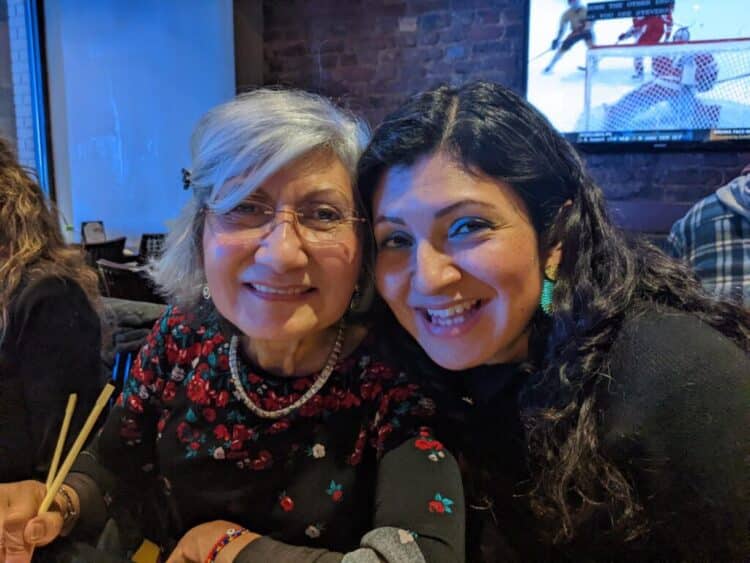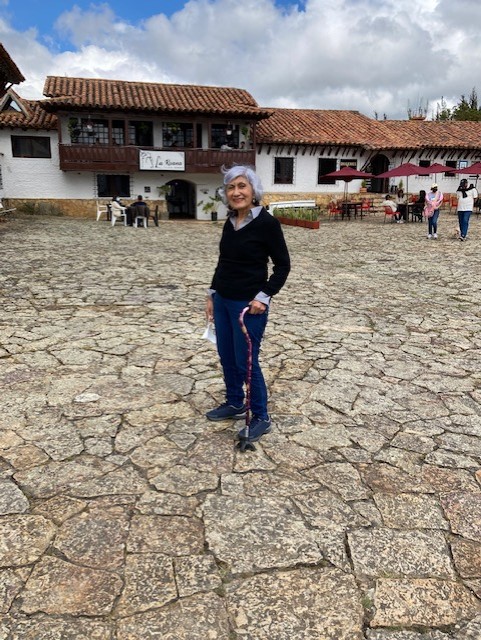
Choose Your Language:
Posted by: The Sumaira Foundation in NMO, Patient

On April 29, 1984, I landed at Boston’s Logan Airport with two suitcases and a seven-year-old girl holding my hand. This trip concluded a process that had begun three years before when my sister, who lived with her husband and her daughters in Massachusetts, asked me if I wanted to immigrate to the United States. After evaluating the few possibilities I had in Colombia to fulfill my aspirations of getting a master’s degree, and with the desire to give my daughter a high-quality education, I answered affirmatively, and she began the petition process.
When I received the consular note with the approval of the resident visa, I began to prepare. I sold my car and my personal belongings, quit my job at an American oil drilling company, and my professorship in economics at the university where I graduated. I converted everything into U.S. dollars and, with a broken heart, left my mother crying inconsolably at the airport. Friday, April 29, we left Colombia.
Since that day, 38 years have passed, 34 of which involved a lot of effort, intense work, learning how to adapt to a new social and business culture, seeking study and work opportunities, living pleasant and happy moments, and also sadness and tears. I met wonderful people who opened many doors for me and from whom I have learned a lot. The American dream was fulfilled beyond all expectations. An MBA from the University of Massachusetts, a successful professional career in economic development with working experiences in the banking sector, the mayor’s offices of Miami and Boston, in housing development, and in management of non-profit agency operations; a six-figure annual salary, three properties in the United States, one in Bogotá, and a daughter who graduated from Harvard. All this was achieved with effort, tenacity, and commitment.
But this dream come true was abruptly cut short in May 2018. I took a week’s vacation from my job in Boston and traveled to Miami to visit a friend. In those days, I swam and did yoga twice a week. I wanted to do the same thing in Miami. After swimming, I would get into the Jacuzzi for 10 minutes, placing my body under the jet of hot pressurized water, looking for a relaxing massage for my back. On the third day, I noticed that the skin on my back was very sensitive to touch, and I felt a bizarre sensation in my body throughout the day; it was Wednesday. The next day, I woke up with a strange numbness on the right side from the back to the abdomen. Each day, the numbness spread and continued down my stomach, hip, and thigh.
I returned to Boston to work, but the numbness covered my entire leg, and I began to limp and drag my right foot. I made an appointment with my neurologist, and she immediately ordered an MRI; being Memorial Day weekend, there was no availability until the following week. Every day it was more challenging to walk. Getting on or off the bed was a feat. The numbness and tingling continued traveling further each day until reaching my feet. I lost the strength in my right leg and could no longer drive my car. Friday, May 25, I worked from home, and this was the last day of my active participation in working life. On Saturday, both my legs were paralyzed, and my bladder stopped working. My daughter and her husband took me to the emergency room at Beth Israel Hospital in Boston. An MRI confirmed a spinal cord injury extending from vertebrae T2 to T7 and showed old demyelinating lesions in the brain. Laboratory tests and analysis of a sample of spinal fluid sent to the Mayo Clinic returned a positive result for Neuromyelitis Optica Spectrum Disorder (NMOSD). All the protocols were applied to counteract the effects of the attack and reduce inflammation.
I thought that all this would be temporary and that I would be able to return to my job in a few weeks. I received visits, bouquets, and cards of support from my employees. These expressions of appreciation made me want to return even more. After a week of treatment, I was transferred to the Spaulding Rehabilitation Hospital, where physiotherapists performed the miracle of getting me back on my feet. They trained me on how to do things for myself. We focused on the basics like putting on shoes and getting dressed, bathing, folding clothes, buttoning a shirt, managing in the kitchen without falling, going up and down stairs, and even getting in and out of a car. Three weeks later, I was sent home with a walker, a splint on my right leg that helped keep my ankle stable and raise my toes, and an exercise program. The hospital arranged for a nurse and physical therapist to visit me during the week to continue the physical therapy program.
July came, and with it, a hot summer. While waiting for my first infusion of Rituximab to prevent relapses, I suddenly began to feel that even walking small distances between rooms drained my energy and that it was hard to breathe. These symptoms worsened, and one morning, I found myself so short of breath and at high risk of falling that I decided to call the hospital. The nurse who responded kept me on the line until the fire department and an ambulance arrived. The cycle repeated itself: paralysis again, chest tightness, worsening spasticity in the right leg, loss of sense of touch in the left leg, and numbness of the body from chest to toes.
That was when the immense sadness and depression arrived. After all the effort and all the will I had put into recovering, I was back at the same point. Again starting from scratch.
One morning at Beth Israel, a nurse on duty noticed that I was crying. She came to talk to me and asked if I wanted to go out in the sun. She found a wheelchair and took me to the street, to a square where there were flowers, and people were walking. She walked me around to enjoy the morning sun for a while and then took me back to my room. It was a gesture of empathy and solidarity, and I always remember it with gratitude. I didn’t know her name, but I will never forget her.
The damage caused by the second relapse ended my aspirations to return to work. Mobility was increasingly complicated. My job responsibilities included managing the operations of an organization with more than 300 employees and required me to be constantly moving. It would be impossible in my condition. I had to resign myself to forced retirement. This was another huge emotional loss; once again, I felt out of place. 2018 ended, and my life would never be the same as before.
The occupational therapist at Spaulding recommended me as a good candidate to learn to drive with a hand control system. I passed the evaluation, and I signed up for the training. There were fifteen sessions, and with the help of the training therapist, I made an appointment for the driving test with the Department of Transportation. The trainer had prepared me well, so I passed the exam without problems and was given a new driver’s license. Bingo! Then came the time to look for a new car that could have the hand control system installed. With the help of friends, I decided on a 2020 Toyota Corolla. Once the car was ready, I hit the streets and could have more independence and enjoy outings in the city.
2019 was the most stable year; I felt I had reached the best point of my recovery. I volunteered for two non-profit organizations. In the first one, I advised the Board of Directors on how to better manage the budget and the projection of income and expenses using various financial analysis methods. In the second, I helped register and evaluate immigrants who wanted to learn English. These volunteer jobs helped me connect to the outside world and feel useful. From time to time, I would get together with friends to celebrate birthdays or in the summer with a group of Colombian friends. I was still living with the aftermath of my illness but had learned to deal with it. I continued the Rituximab infusions every six months and would return to Spaulding twice a year for outpatient physical therapy to improve my balance and maintain the level of strength I had regained in my legs.

I felt so strong that I decided to plan a trip to Colombia alone. As I was unsure of the return date or the route, I bought only the one-way ticket and made all the arrangements to be transported in a wheelchair at the airports. The Boston-Toronto-Bogotá trip was long but without setbacks. I arrived, and my niece was waiting for me. I felt good; the city’s elevation did not affect me, and I was happy to see its lights again and the green mountain range in the background. I reconnected with old friends and my countless cousins.
Since I had time and wanted to get away from the Boston winter, we planned a trip to Ecuador. We were in the south, close to the sea and Peru. We went to Cuenca, a beautiful colonial city in the mountains and –surprise- where many retired Americans live. A quiet and peaceful place with an ideal climate. After ten days, we returned to Bogotá.
One night at the end of January, I felt my hands freeze and a tightness in my chest. Scared, I woke up my niece and asked her to take me to the emergency room of the La Colina Clinic, a nearby hospital. The neurologist on duty examined me and told me that in 2019 they had treated six patients with NMO, and I was the first in 2020.
Since I was feeling better, the doctor sent me home with the recommendation to return if I felt any new symptoms. A few days later, I noticed that the left part of my chest was numb and that my bladder had emptied before I had time to get to the bathroom. We quickly took a taxi to the emergency room in La Colina. A neurological exam and an MRI confirmed a new injury and extensive swelling in the spinal cord. Again paralysis in the lower limbs and numbness in the whole body except arms, neck, and head. Neurologists applied the same protocols to reduce inflammation as in the United States. At the end of the five days of intravenous methylprednisolone, there was minimal improvement in the symptoms.
The three neurologists who treated me recommended plasmapheresis to remove the white cells from the blood plasma. I decided to accept the treatment to buy time while we applied for an emergency humanitarian visa so my niece could accompany me on the trip back to Boston. So I spent another seven days in the intensive care room while I had plasmapheresis sessions once a day. I left the hospital in a wheelchair accompanied by my niece and a nurse. I returned to the hotel while travel arrangements were made. On February 20, after 15 days of hospitalization, we left on a Bogotá-Washington D.C.-Boston flight. My daughter greeted us, and we went directly to Beth Israel Hospital from Logan Airport. Another week there and then two more in rehab at Spaulding Rehabilitation Hospital.
In March, I was scheduled for two Rituximab infusions, with a week between them. Meanwhile, the COVID-19 virus epidemic was spreading by leaps and bounds. Soon, countries would close their borders and airports to passenger traffic. I left Bogotá just in time.
In April,l I began to feel pain in my fingers when I extended or contracted them or by touching them; later, my hands began to shake and lose strength. My arms contorted in excruciatingly painful spasms that lasted about a minute and passed. Walking also became more difficult, and I could not lift my right leg. My neurologist ordered me to start methylprednisolone infusions. The COVID-19 pandemic exploded, and I had to do the infusions as an outpatient because hospitals only received seriously ill patients. The methylprednisolone helped, but the spasms in my arms were unstoppable. My fingers went numb, and things fell out of my hands; I couldn’t write or drive my car. NMO was attacking my arms and hands regardless of how much I prayed it would not.
Spaulding closed outpatient therapy services, and I had to spend the entire relapse and its aftermath at home, trying to do therapy myself. The hospital opened very slowly in mid-June, with one therapist, one patient at a time. I started with one physical therapy session a week. Later I was able to add occupational therapy, which helped me gradually regain the use of my arms and hands.
As I saw that my situation was getting more complicated, I asked my daughter to help me contact Dr. Michael Levy. I met in 2019 at the NMO Patient Day sponsored by Brigham and Women’s Hospital in Boston. Dr. Levy had come from Johns Hopkins Hospital in Maryland to create a research center for NMO and other related diseases in the Massachusetts General Hospital and to take up an academic position at Harvard University School of Medicine. A second opinion from Dr. Levy would be invaluable. Due to the pandemic, we could not see Dr. Levy until July. Upon reviewing my history and laboratory work, Dr. Levy concluded that in my case, Rituximab was not effective in preventing relapses from the beginning of my illness. He then invited me to participate in a clinical study of a medicine that was being tested to see if it was effective and safe in the preventive treatment of NMO. It was a three-year study sponsored by the manufacturer. I gladly accepted. After a series of exams, MRIs, and consulting with my neurologist at Beth Israel, Dr. Levy submitted my case to the drug company for consideration. I was accepted in September 2020. Since my inclusion in the study, I go to Mass General for IV infusions every eight weeks. During all this time, one year and ten months, I have been relapse-free, and I hope to stay that way for the rest of my life.
Since I was diagnosed with NMOSD in June 2018, I have had three relapses. They have severely affected my legs, arms, and hands, compromising my ability to walk and do many things I used to do with ease. My body is numb from chest to toes, and I have to endure neuropathic pain in my feet, legs, arms, and hands. Months of physical and occupational therapy have trained my legs to walk with difficulty and my hands and arms to do my personal care. Now I can perform simple tasks around the house, allowing me to live a semi-independent life.
NMO changed my life in ways I couldn’t even imagine in my wildest dreams.
Every day is a challenge, a struggle to stay positive and not give up. I have learned to be more resilient and patient and accept my weaknesses without punishing myself.
I value more time, family, and friendship. I am lucky to have the support network I have:
As of July 20, 2022, when I write this story, the painful spasms in my arms have subsided. I have regained the flexibility in my hands and fingers to write and sign my name again. I cook and help prepare dinner for my family. However, there are things that I cannot do; carrying grocery bags, bending over, cleaning floors, climbing stairs, and I get drained walking. But one thing that makes me very happy is that after more than two years, I have become strong enough to drive my car again.
In 2021 I was invited to be part of a group of mentors for people who want to start a business or already have one and want to expand or improve it. This volunteer work is done through weekly virtual meetings with the entrepreneurs and has been gratifying. This has been another victory over the crippling effects of NMOSD.